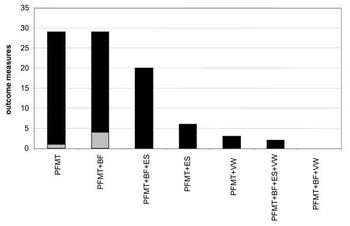
There are many ways to take estrogens and many philosophies of management. The views expressed on this page represent the opinion of the author and may or may not conform to the current "standard of care" prevalent in the United States today.

There are many ways to take estrogens and many philosophies of management. The views expressed on this page represent the opinion of the author and may or may not conform to the current "standard of care" prevalent in the United States today.

A 27-year study of 1300 women undergoing retropubic cystourethropexy using either the modified Marshall-Marchetti-Krantz procedure or the modified Pereyra procedure compares long-term results when the type of surgery is selected on the basis of patient criteria.

In many mammals, the duration of the nocturnal melatonin elevation regulates seasonal changes in reproductive hormones such as luteinizing hormone (LH). Melatonin's effects on human reproductive endocrinology are uncertain.

Natural Estrogens, Selective Estrogens, Fantasy Estrogens... What is the Perfect Estrogen?

Perhaps the principal reason male menopause has never been in the public spotlight is because men who experience the characteristic decline in virility during middle age are reluctant or even unwilling to acknowledge the condition.

This is adapted from an interview with Dr. Howard Glazer, who has developed a treatment for this condition using a form of biofeedback. This initial interview, covers the history of the disease, as well as Dr. Glazer's background.

The Treatment of Vulvovaginal Pain Disorders with Surface Electromyographic Assisted Pelvic Floor Muscle Rehabilitation

Receiving a diagnosis of cancer is a major life change. Neither the patient, the family nor friends will be the same again.

Body Mass Index, Percent Body Fat, and Regional Body Fat Distribution in Relation to Leptin Concentrations in Healthy, Non-Smoking Postmenopausal Women in a Feeding Study

The post marketing safety surveillance program for a drug containing a new chemical entity should assess both, the safety outcomes that relate specifically to the targeted population, as well as those that could potentially be related to special pharmacological characteristics of the drug.

Human, animal, and in vitro research indicates a beneficial effect of appropriate amounts of omega-3 (n-3) polyunsaturated fatty acids (PUFA) on bone health.

Many risk factors for fractures have been documented, including low bone-mineral density (BMD) and a history of fractures.

Urinary incontinence impacts 15 to 35% of the adult ambulatory population. Men after the removal of the prostate for cancer can experience incontinence for several weeks to years after the surgery.

Diagnostic discordance for osteoporosis is the observation that the T-score of an individual patient varies from one key measurement site to another, falling into two different diagnostic categories identified by the World Health Organization (WHO) classification system.

Stress urinary incontinence (SUI) is a prevalent and costly condition which may be treated surgically or by physical therapy.

The relationship of sex hormones and breast cancer is a matter of concern of many women. Breast cancer is the most common form of cancer in women in industrialized countries.

The request for "natural hormones" is nearly universal. But there is a lot of misunderstanding regarding this idea. What is natural? Compounds derived from nature? Or compounds from pharmaceutical companies that are structurally similar to hormones produced by the ovaries?

Although testosterone is generally considered to be a male hormone, it is produced in small amounts by the ovary. Other hormones with testosterone-like effects are also produced by both the ovary and the adrenal gland.

Menopausal women often present with a list of complaints, questions and worries. While they seek effective treatment to alleviate their symptoms, they express their concerns regarding the potential adverse effects associated with conventional hormone treatment-namely, coronary heart disease, stroke and breast cancer. As a result, many women ask their clinicians about alternative options. They come armed with anecdotal stories, advice from friends, and information from television and internet sources.

Initiating Discussions, Dispelling Myths, and Finding Solutions

The 400-meter timed walk can provide insights into an older person’s cardiorespiratory fitness; the resulting data from these walks are useful in predicting total mortality, cardiovascular disease, mobility limitation, and disability. But do leisure time activities and weight/body composition changes affect walk time? Dr Kelley K. Pettee Gabriel from the division of epidemiology, human genetics, and environmental sciences at the University of Texas Health Science Center, Austin, and colleagues believe a better understanding of this relationship will help clarify the best use of the 400-meter walk in middle-aged women.

In general decline in fertility is associated with increasing age, most notably for women. Women are born with a fixed number of oocytes which diminish with age leaving few if any capable of fertilization in the peri menopause.

The purpose of the Women’s Health Initiative hormone program was to study the health benefits and risks of hormones for postmenopausal women. In July 2002, we asked women in the estrogen plus progestin part of the program to stop taking their study pills.

Reports of recent studies revealing hormone replacement therapy (HRT) is associated with health risks have left women scared and confused about how to stay comfortable and healthy during menopause.

Estrogen plus progestin therapy does not have a clinically significant effect on postmenopausal women's health-related quality of life, according to this analysis of data from the Women's Health Initiative (WHI), a randomized, double-blind, placebo-controlled trial.